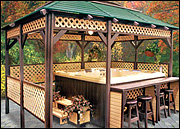Gazebos
 Today's gazebos come in just about every size, style and shape imaginable, from intimate, open-air havens for quiet lounging to spacious, fully enclosed models for creating a personal day spa, to a room equipped with sophisticated cooking and entertainment systems. A backyard gazebo can be customized to reflect a family's unique lifestyle and taste.
Today's gazebos come in just about every size, style and shape imaginable, from intimate, open-air havens for quiet lounging to spacious, fully enclosed models for creating a personal day spa, to a room equipped with sophisticated cooking and entertainment systems. A backyard gazebo can be customized to reflect a family's unique lifestyle and taste.
Here are some ideas and tips to consider so that you choose a gazebo that best suits your needs and lifestyle:
Where To Put Your Gazebo?
Since aesthetics are important you may want to highlight your structure by making it the center of attention in your garden or blend it into your landscape to make it a secret hideaway. There are no rules - so be creative and have fun. A good design tip is to be conscious of your gazebo's relationship to the rest of the structures on your property. Before you have the cement poured, think about what your gazebo will look like during all four seasons. The surrounding foliage (and weather) can look very different from one season to the next. All of these considerations should have some impact on where you locate your gazebo.
From a functional perspective, avoid low-lying areas where water can collect. Set it on a level or elevated spot in order to keep it - and you - dry, and to maximize the view. Before building, make sure you or your contractor consults the local building department about whether you need a permit.
Size Matters
Another major consideration is the size of your gazebo, because once it is erected you won't be able to enlarge it. Bigger is definitely better when you build a permanent gazebo. Once you're in it - you'll quickly realize its potential as an outdoor retreat, and you'll want to accessorize it. Most manufacturers offer sizes that range from eight feet to as large as you want, however the most popular size is 100 square feet.
The key is to ensure that your space is large enough for its intended purpose, while remaining proportional to the setting. A good rule of thumb is that an eight foot gazebo fits two people, two chairs and a small table. With every two-foot addition, two more people can be seated comfortably in the gazebo (for example, a 10 foot gazebo holds four people comfortably, a 12 foot gazebo holds six people comfortably, etc.)
Materials
A gazebo is generally defined as a freestanding, open-sided structure with a solid roof and (usually) a floor, though designers are constantly reinterpreting the form. While traditionally made of wood, gazebos also can be built of metal, stone, vinyl or even reinforced concrete. Cedar and redwood are the top wood choices because of their stability and weather resistance. Both woods can be painted or left unfinished. Pressure-treated lumber (generally pine) is a less expensive option, but it should be covered with a semitransparent stain. Floors, which are often raised by one or two steps, may be wood, brick, concrete, or stone. Most often, the roof is covered in cedar shakes, though other materials, including copper and slate, may be used, especially if you want it to match your house.
Dazzling Designs
Keep in mind that the design of your gazebo needs to blend with the landscape and work with the style of your house. Most manufacturers offer a line of gazebos that come in various shapes and styles, including octagon, rectangular, oval, double roof octagon, double roof rectangular and double roof oval.
Another nice touch is creating a pathway that leads to the entrance of your gazebo, using flagstone or other paving products.
You can have your gazebo fully enclosed by choosing your own doors and windows (be sure they come with screens) or choosing your own railings and wood patterns for an open gazebo. Most manufacturers have their own line of gazebos, which have their own architectural details and accessories like balustrade panels, decorative corbels and roof accents. A good manufacturing company usually has a web site that details each of its gazebos.
Cost
A high-quality, customized kit starts around $2,000 to $3,000 for a six to eight footer and can go to about $10,000 for a larger kit with added features. Do-it-yourself kits start around $2500 and are generally made from treated pine (aluminum designs are also offered by some manufacturers). When it comes to labor, you can expect to pay $500 and up for labor, plus the cost of the foundation.
Popular Options
Get wired: while you don't have to wire your gazebo, it is a very popular option because it not only provides interior lighting, but can be used as an outlet to power a lamp, a blender for mixing drinks, a small refrigerator or a plug-in stereo system. If you really want to highlight your gazebo considering having swimming pool lights in the floor.
Screening the sides will deter mosquitoes from joining your dinner parties, while adding removable windows can extend the gazebo's use in cooler weather. Sliding lattice-panel sides provide privacy screening as needed. For extra sitting, you can opt for built-in benches.
In warm climates, the gazebo is often built complete with a hot tub, but be sure your gazebo is large enough so that it doesn't turn into a giant covering for your hot tub.
Wooden and vinyl gazebo manufacturers offer a number of optional add-ins, so you can create a customized gazebo. Rail and brace design, optional hidden wiring, removable screens, doors, cupolas, treated or untreated wood, painted or unpainted, these are just a few of the features you can decide on when designing your gazebo.



.png)
.png)


